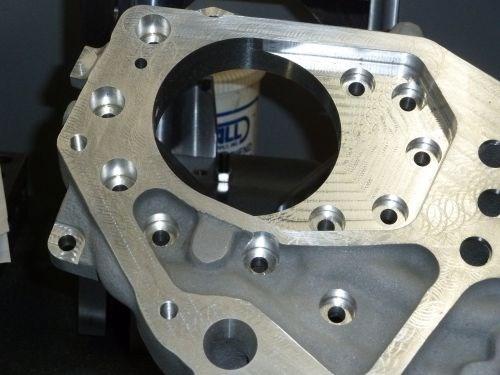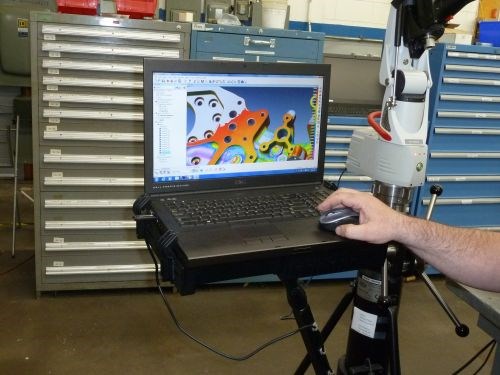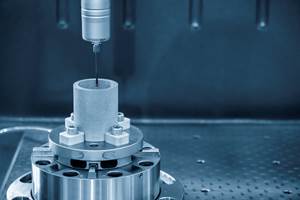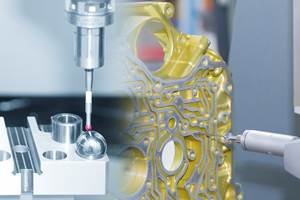Mobile Metrology
When Clinkenbeard of Rockford, Illinois, decided to invest in a Romer six-axis portable metrology arm in the fall of 2013, they expected it to help ensure the quality of the parts they make. What they didn’t expect was the host of additional benefits the device would provide.
Share







Mark Vance positions the Romer six-axis portable metrology arm above a part to be measured, allowing the laser to read the part’s surface and transfer the data to the computer monitor where a variety of tests and simulations can be run.
When Clinkenbeard of Rockford, Illinois, decided to invest in a Romer six-axis portable metrology arm in the fall of 2013, they expected it to help ensure the quality of the parts they make for the aerospace, automotive, power generation, military and industrial markets. What they didn’t expect was the host of additional benefits the device would provide. “We’ve identified so many uses for the arm that it paid for itself much more quickly than we’d anticipated,” says Steve Helfer, general manager.
The Romer arm utilizes a 3D laser coordinate system to determine part accuracy. Lightweight, highly flexible and portable, the arm checks parts where they are being machined rather than requiring transport to the CMM lab. In addition, the arm can be used to measure parts of any size, with special software that automatically “knits” partial images of larger parts together onscreen. “You just take a series of images and let the software join them together,” says Kevin Knight, manufacturing engineering manager. “The Romer arm makes measuring both large and small parts equally simple to accomplish.”
The base can attach to magnetic, desktop and freestanding mounting systems. Aerospace-grade carbon fiber tubes and a “zero-G” counterbalance provide easy manipulation of the fully articulated arm, and patented Infinite Rotation allows a full range of movement, which is helpful in tight spaces and when working with complex parts. The ergonomic arm is so well-balanced, in fact, that its pistol grip is said to feel as if it is floating in the user’s hand.
In operation, the user scans the part on the machine, the shop floor or on a worktable. As the red laser reads the object its shape begins to appear on the attached computer monitor, eventually resulting in a 3D image that can be overlaid across the CAD original to check for accuracy. In addition, “color scans” can be run that assign differing tolerances to specific areas of the part, showing a color-coded representation of part accuracy. “Parts that might have once taken weeks to check against drawings can now be measured in a matter of minutes with an incredibly high degree of accuracy,” says Mark Vance, advanced technical specialist.
Mr. Helfer says that Clinkenbeard offers demonstrations to customers who are interested in learning about the technology, and it has even taken the Romer arm in its portable case to conduct on-site testing for other companies in the Rockford area. “Not only have we found more internal applications than we’d anticipated, but also external uses that we hadn’t even considered,” he says.

Detail of a part being to be scanned for comparison against the original CAD design.

The resulting image of the scanned part, showing the “color coding” feature that represents different tolerances achieved and even “overlays” of scanned images on CAD drawings.
Related Content
Parts and Programs: Setup for Success
Tips for program and work setups that can simplify adjustments and troubleshooting.
Read MoreRethink Quality Control to Increase Productivity, Decrease Scrap
Verifying parts is essential to documenting quality, and there are a few best practices that can make the quality control process more efficient.
Read More4 Ways to Establish Machine Accuracy
Understanding all the things that contribute to a machine’s full potential accuracy will inform what to prioritize when fine-tuning the machine.
Read MoreHow to Evaluate Measurement Uncertainty
Manufacturing and measurement are closely coupled. An important consideration for the use of measurement results is the associated measurement uncertainty. This article describes common metrology terms and provides an example uncertainty analysis.
Read MoreRead Next
Machine Shop MBA
Making Chips and 91ÊÓƵÍøÕ¾ÎÛ are teaming up for a new podcast series called Machine Shop MBA—designed to help manufacturers measure their success against the industry’s best. Through the lens of the Top Shops benchmarking program, the series explores the KPIs that set high-performing shops apart, from machine utilization and first-pass yield to employee engagement and revenue per employee.
Read MoreLast Chance! 2025 Top Shops Benchmarking Survey Still Open Through April 30
Don’t miss out! 91ÊÓƵÍøÕ¾ÎÛ's Top Shops Benchmarking Survey is still open — but not for long. This is your last chance to a receive free, customized benchmarking report that includes actionable feedback across several shopfloor and business metrics.
Read MoreAMRs Are Moving Into Manufacturing: 4 Considerations for Implementation
AMRs can provide a flexible, easy-to-use automation platform so long as manufacturers choose a suitable task and prepare their facilities.
Read More





















